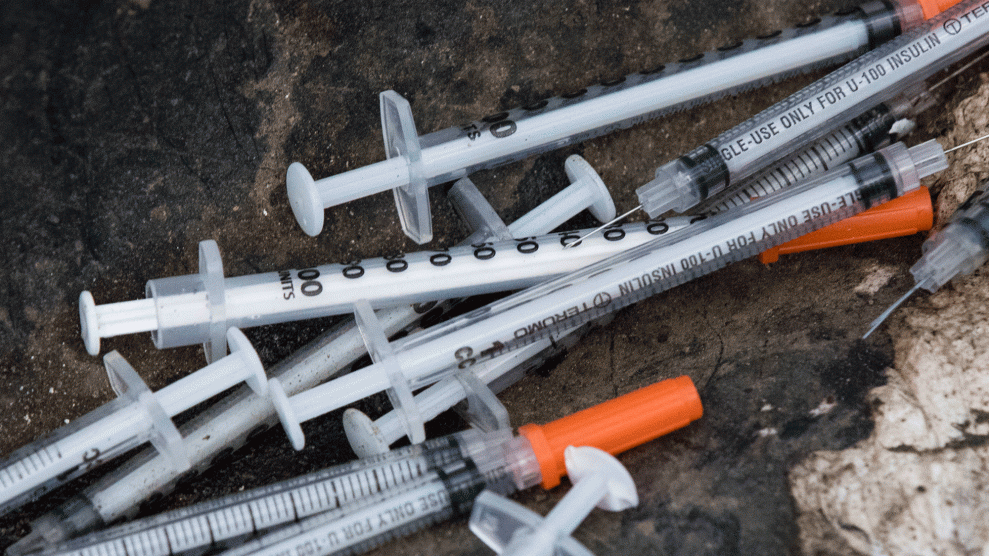
In 2013, leaders at Partnership HealthPlan, the main public insurance provider for Medi-Cal patients in rural Northern California, discovered an alarming trend: Many counties where Partnership operated had among the highest rates of opioid prescribing and overdose in the state. Hydrocodone was the top-prescribed medication among Partnership patients, who include more than 570,000 Medi-Cal recipients from the vineyards of Sonoma County to the redwoods on the Oregon border. In Lake County, a poor, rural area bordering Sonoma, enough opioid painkillers were prescribed in 2013 to medicate every man, woman, and child with opioids for five months, according to a report by the California Health Care Foundation.
“If people were needing more, you just prescribed more,” said Dr. Marshall Kubota, a regional medical director for the provider. “That was a recipe for disaster.”
Opioids, a highly addictive class of compounds that includes OxyContin, Percocet, and Vicodin, are a uniquely American form of pain treatment: In 2014, the United States consumed nearly 70 percent of the world’s supply. As prescriptions have soared since 1996, when Purdue Pharma introduced OxyContin, opioid addiction and overdose rates have outpaced the trend. Yet chronic pain levels have increased, according to a recent study in the medical journal Pain—and many people who started on painkillers have transitioned to other illicit, stronger opioids like heroin or fentanyl. As a result, drug overdoses, most involving opioids, kill more than 1,000 Americans each week on average—more than HIV did at its peak in the mid-90s.
Kubota and his Partnership colleagues were faced with a question: How does a system of doctors change the decades-old practice of treating pain—from an ankle sprain to a chronic back problem—with addictive pills? And if not opioids, what do you give patients in pain?
Government researchers have been studying those same questions. Last year, the Centers for Disease Control and Prevention recommended that doctors avoid prescribing opioids for chronic pain and instead pursue alternative medications. Some antidepressants and anti-seizure drugs can help quiet down the brain’s pain signaling. Physicians have found that sleeping pills can also be helpful, since chronic pain interferes with sleep, leading to a snowball effect where the body doesn’t restore itself as well as it would otherwise. Evidence suggests that the chemical compounds in marijuana could help some types of chronic pain, too. (And such studies aren’t just from California hippies: A recent New England Journal of Medicine article, co-authored by National Institutes of Health Director Francis Collins, says there is “strong evidence” that cannabinoids can treat pain.)
Even for acute pain, like that from a broken bone, opioids are often prescribed when a carefully calibrated cocktail of over-the-counter medications can do the trick just as well, says Nora Volkow, director of the National Institute on Drug Abuse. For example, one study published by the Journal of the American Dental Association found that a combination of ibuprofen and Tylenol is more effective in treating pain after wisdom teeth extraction than oxycodone. Another study in the Canadian Medical Association Journal found that for kids with fractures, ibuprofen is just as good at curbing pain as morphine.
Kubota and his colleagues took a multipronged approach. They required their physicians to attend courses about pain management, from “Rational and Irrational Opioid Prescribing” to “The Art (and Very Little) Science of Tapering Opioids.” They developed guidelines for emergency rooms and dentists—things like using Tylenol and local anesthetics before resorting to opioids to treat dental pain. They also prohibited doctors from prescribing more than 30 days of opioids unless a patient went through a strict authorization process.
But perhaps the most significant—and controversial—changes involved taking some opioids off the plan altogether. Partnership stopped covering potent, brand-name pills, many of which have high street value. It began suggesting antidepressants and anti-seizure medications for pain management. With the money Partnership saved on opioid prescriptions—about $1 million per month—it offered alternative benefits to patients, from chiropractic sessions to acupuncture.
All of this was a tough sell for doctors. “We became the bad guys,” admits Kubota. The hardest part for a lot of physicians was having what Kubota calls “the talk,” when doctors would inform patients that the new policy likely wouldn’t cover their continually increasing opioid dosages.
The talks paid off. Between 2014 and 2016, the number of Partnership patients on dangerous levels of opioids decreased by 79 percent. In the first quarter of 2017, Partnership clinicians prescribed about 70 percent fewer painkillers than they did in the first quarter of 2014. (By contrast, opioid prescribing rates nationally declined by 13 percent between 2012 and 2015 but were still three times higher than 1999 rates, according to the CDC.)
Kaiser Permanente of Southern California, which serves roughly 4.4 million patients, took a similar approach. According to the California Health Care Foundation, the Kaiser physicians now receive reports comparing their prescribing rates with those of their peers, and they require a signoff from another doctor specializing in pain management, oncology, or palliative care to give high doses of opioids or brand-name pills. Opioids prescribed by emergency department doctors are limited to three days. An online tool lets physicians consult a pain management specialist about specific cases in real time. Between 2013 and 2015, the health plan saw a 31 percent drop in the number of patients on unsafe doses.
Contrary to some doctors’ concerns, patients reported being more satisfied with Kaiser than before. Partnership physician Marie Mulligan says that after she curbed opioid prescriptions, her patients took on old hobbies that they had abandoned because of the pain; some have gone back to school or become more involved with their families. As she put it, “It’s getting them to gradually wake up.”













